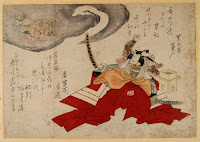The Siege of Odawara (1590) was a definitive battle that made Hideyoshi Toyotomi the unifier of Japan. Yoshitaka Kuroda, who is also known as Kanbei or Josui, joined this battle with only 300 soldiers to support Hideoshi. It was Yoshitaka who settled the prolonged battle by persuading the Hojo Family to surrender.
The Hojo family was then having a long meeting to determine whether they should counter or surrender while surrounded by enemy forces. The historic meeting originated the phrase “Odawara Hyojo” (a meeting of Odawara), which refers to a meeting that doesn’t reach a conclusion after a long time.
Yoshitaka bravely entered Odawara Castle, in what is now Kanagawa Prefecture, in the defining moment, and successfully convinced Hojo Ujimasa and the Ujinao family to surrender the castle to Hideyoshi. Ujinao gave the sword Nikko-Ichimonji to Yoshitaka as a sign of appreciation for his help in communicating with Hideyoshi. According to the Kuroda Kafu (History of Kuroda family) written by Kaibara Ekiken, the sword was given to Yoshitaka together with the Hojo Shirogai, a trumpet shell, and the Azuma Kagami, a history book.
 |
| Long Sword Nikko Ichimonji Hilt, point and entire body |
The license given to Kuroda Nagamasa from Hideyoshi on July 10th, right after the surrender of the Hojo family, suggests that the battle successfully ended thanks to Yoshitaka’s wit. Considering that the Siege of Odawara was the final battle before Hideyoshi unified Japan, it is safe to say that it was Yoshitaka who put an end to the warring states period which continued for 100 years. The Nikkou Ichimonji is a commemorative relic, which symbolizes this historical fact.
The Nikko Ichimonji had been enshrined in the Nikko Gongen Shrine, also known as the Nikko Futarasan Shrine in present day Gifu Prefecture, until it was bestowed to Hojo Souun, the first lord of the Hojo family. The sword has become the family treasure of the Hojo Family since then. Although it has no signature of the swordsmiths, it is a masterpiece of the Bizen Fukuoka Ichimonji School, having a clear sword mark called juka choji (multilayered clove shapes).
The wide and relatively thin blade retains the sword form of the old days.
On the front side of the blade, a reflection called utsuri is stretched diagonally from the bottom to the point, and the irregular sword marks called midare utsuri, are spread across on the blade.
On August 8th, 1623, about a month after Kuroda Nagamasa’s death, Kuroda Tadayuki, the second lord of the Kuroda Family, ordered Umetada Myoju, a metalsmith, to make sword fittings of uchigatana style for Nikko Ichimonji.
The order form precisely suggested how the sword should look like as follows:
●The two-ply metal collar should be made of pure Insu gold from China. The top of the collar must have an open work of paulownia crest.
●The Sword hilt washer with a jagged rim and a shitodome, a metal fitting to cover a hole for inserting sageo thread should be also made of kinsu gold.
●Fuchi, the hilt collar should be made of red bronze and must be nimen-fuchi design.
●The sheath should be made of sharkskin dyed in dark blue.
●The Kuroda family will provide a sword hilt, kogai, (a small knife-like object), koduka (a small sword) and a handguard.
●Kurikata and Kaeritsuno, (protrusions of the sheath to make sure the sword is hanged in the right position) and the pommel of the sword should be made of horn.
●Kojiri (a tip of a sheath) should be made of brass and be treated by Kusarakashi-te method.
Also, at the end of the order form, a description was stated “The sword fittings must be made to look exactly like the one for Heshikiri Hasebe”. (It doesn’t refer to the current sword fittings of Heshikiri Hasebe, which was made after the sword fittings of Atakigiri at the end of the Edo period.)
Unfortunately, the sword fittings for both Heshikiri Hasebe and Nikkou Ichimonji were no longer exist, but we can imagine how they looked like by reading those descriptions.
According to “Okura Ohitsugen Oshina Irikumi Cho”, a sword book of the Kuroda family at the end of the Edo period, Nikko-Ichimonji’s sheath was described as “The black sheath with purple sword strap” “Spare sheath in the same design” and it seems that the original sheath was already lost at this point. (The two black sheaths were also lost.)
 |
| Sword box grape-and-vine leaf motifs with its lid open |
According to the History of Kuroda, the sword of Nikko Ichimonji, placed in this box was given to Nagamasa. The box is audaciously designed in a way that the grapevine is winding around the surface of the box. The lacquer was also applied to the area which is hidden when the box is closed. This box is a real masterpiece that shows the distinguished skill of the craftsman everywhere.








































